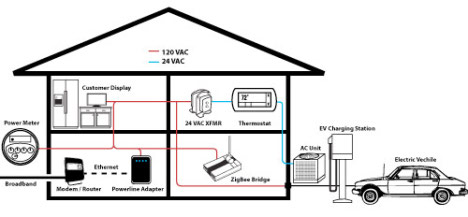
Being one of the most anticipated high-tech gadgets for this year, “Google TV” is no longer a visionary invention. It has finally made its debut appearance at the Google I/O Convention earlier in May. Google TV is an integrated system which comprises the functions of a PC, Media Player and Internet Device all in one. While most of the details are yet to be released (including the SDK – Software Development Kit), the actual product will not be shipped until the end of this year. Nonetheless, through previewing its design structures we should be able to forecast how Google TV will withstand market competitions with its breakthrough design concepts:
First, let’s take a look at Google TV’s concept in design structures:
Google TV is built upon the structure of complex Hardware, Software, Technology Standards (Specifications), and Content Resources. The combination of each structure needs to work seamlessly to achieve optimum performance; the compatibility and interoperability of each device or element must therefore become critical and essential.
Hardware
Google TV’s core structure is built upon multiple hardware devices as the operating environment; therefore, the interoperability among the connecting devices becomes significant. For example, an Android mobile phone, wireless keyboard and a mouse can all be connected to a Google TV. It is the manufacturers’ responsibility to make sure that all devices can be connected properly and operable on the Google TV platform.
Software
Google TV adopts its own Android and Chrome as its primary Operating System and Search Engine. With its strong intention to replace the functions of a PC, some of key checkpoints such as OS stability, application multitasking, and the friendliness to switch between a PC and TV should be thoroughly tested. The biggest challenge will remain with the release of the SDK, when a large quantity of software starts to emerge. Application testing procedures will become the key factor in determining its success.
Technology Standards
Many of the leading industry standards in wired and wireless connecting technologies are specified in the Google TV devices (i.e. HDMI, DisplayPort, Wi-Fi, Bluetooth, DLNA and more). Google TV is also designed to support the playback of cutting edge video and audio in high resolution. Whether it be in 3D Graphics, MPEG4 Streaming or the proper decoding of HDCP, meeting the basic compliance test guidelines to achieve its compliance certificate should all be the minimum requirement during the QA stage.
Content Resources
Finally, streaming content should be able to be downloaded, decoded and played back smoothly at the specified quality level. The content providers such as Hulu, YouTube and others should endeavor to streamline the test procedure in order to maintain the program and broadcasting quality.
An innovative product without quality will only remain visionary. To many people, Google TV is the first step for a PC and TV to finally integrate as one into our living room. Unlike many transitional products in the past, the Google TV adopts leading edge technologies and is aiming to revolutionize the way people watch and utilize television. It will only be meaningful when each and every feature can impeccably work to prove that Google TV is not just another flash in the pan product.

 A few months ago, we wrote about the industry’s anticipation for the latest version of the PCI Express (PCIe) specification. Well, the wait is finally over: the PCI Special Interest Group (PCI-SIG) has officially released PCIe Base 3.0. These
A few months ago, we wrote about the industry’s anticipation for the latest version of the PCI Express (PCIe) specification. Well, the wait is finally over: the PCI Special Interest Group (PCI-SIG) has officially released PCIe Base 3.0. These 




 PCI-SIG
PCI-SIG The
The  Certification testing is available for both DisplayPort-to-HDMI and DisplayPort-to-DVI Dual-mode cable adaptors. Dual-mode DisplayPort cable adaptor certification and testing follow the
Certification testing is available for both DisplayPort-to-HDMI and DisplayPort-to-DVI Dual-mode cable adaptors. Dual-mode DisplayPort cable adaptor certification and testing follow the 
 This growth in adoption presents an enormous opportunity for manufacturers, but the array of consumer devices on the market can make verifying interoperability a challenge. Allion has established its
This growth in adoption presents an enormous opportunity for manufacturers, but the array of consumer devices on the market can make verifying interoperability a challenge. Allion has established its 
 Interoperability testing is a vital step in the manufacturing process. The growing variety of brands, interfaces, standards and electronic functions make it a challenge for manufacturers to ensure that their product will be compatible with other devices. To verify that a product is fully interoperable, manufacturers need to thoroughly test it using a range of real world consumer devices.
Interoperability testing is a vital step in the manufacturing process. The growing variety of brands, interfaces, standards and electronic functions make it a challenge for manufacturers to ensure that their product will be compatible with other devices. To verify that a product is fully interoperable, manufacturers need to thoroughly test it using a range of real world consumer devices. From laptops to cell phones to television sets, our desire to share information over broadband is making wireless connectivity a must-have feature for a range of devices. And, according to a
From laptops to cell phones to television sets, our desire to share information over broadband is making wireless connectivity a must-have feature for a range of devices. And, according to a  For manufacturers looking to capitalize on this growing demand, Allion offers a
For manufacturers looking to capitalize on this growing demand, Allion offers a 

